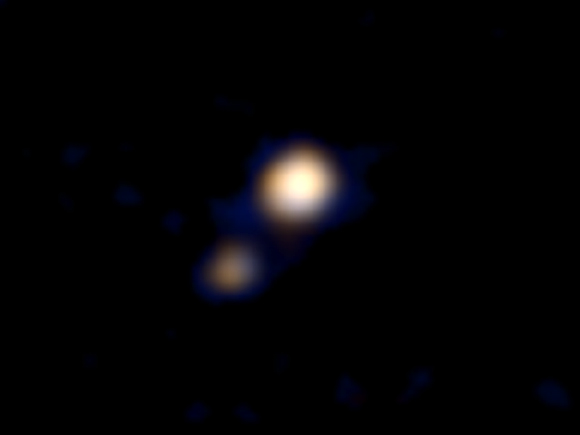The Ralph color imager on NASA’s New Horizons spacecraft has captured a low-resolution color image of Pluto and its largest moon, Charon.

This image from the New Horizons shows Pluto and Charon. It was made from a distance of about 71 million miles (115 million kilometers) – roughly the distance from the Sun to Venus. At this distance, neither Pluto nor Charon is well resolved by the color imager, but their distinctly different appearances can be seen. Image credit: NASA / Johns Hopkins University Applied Physics Laboratory / Southwest Research Institute.
The compact, lightweight, powerfully equipped New Horizons is the fastest spacecraft ever launched. It has traveled a longer time and farther away – more than 9 years and 3 billion miles – than any space mission in history to reach its primary target.
The probe is about three months from returning to scientists the first-ever close up images and scientific observations of Pluto and its system of at least five moons.
Its flyby of the Pluto system on July 14, 2015 will complete the initial reconnaissance of the classical Solar System.
“Scientific literature is filled with papers on the characteristics of Pluto and its moons from ground based and Earth orbiting space observations, but we’ve never studied Pluto up close and personal,” said John Grunsfeld of the NASA Science Mission Directorate at the agency’s Headquarters in Washington.
“In an unprecedented flyby this July, our knowledge of what the Pluto systems is really like will expand exponentially and I have no doubt there will be exciting discoveries.”
“New Horizons is flying to Pluto – the biggest, brightest and most complex of the dwarf planets in the Kuiper Belt,” said Dr Alan Stern, New Horizons principal investigator from Southwest Research Institute.
“This encounter is going to be an exploration bonanza unparalleled in anticipation since the storied missions of Voyager in the 1980s,”
Pluto offers a nitrogen atmosphere, complex seasons, distinct surface markings, an ice-rock interior that may harbor an ocean, and at least five moons.
Among these moons, the largest – Charon – may itself sport an atmosphere or an interior ocean, and possibly even evidence of recent surface activity.
“There’s no doubt, Charon is a rising star in terms of scientific interest, and we can’t wait to reveal it in detail in July,” said Leslie Young of Southwest Research Institute.
Pluto’s smaller moons also are likely to present scientific opportunities. When New Horizons was started in 2001, it was a mission to just Pluto and Charon, before the four smaller moons were discovered.
“New Horizons is one of the great explorations of our time,” said Hal Weaver of the Johns Hopkins University Applied Physics Laboratory.
“There’s so much we don’t know, not just about Pluto, but other worlds like it. We’re not rewriting textbooks with this historic mission – we’ll be writing them from scratch.”







